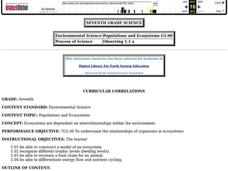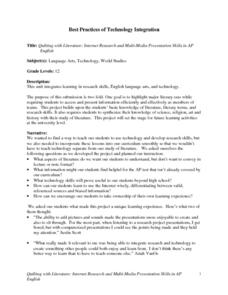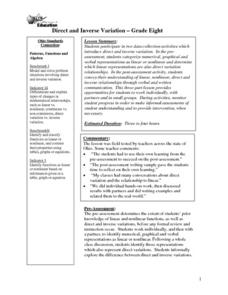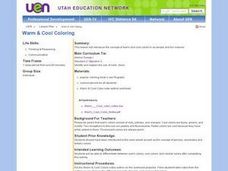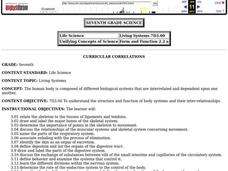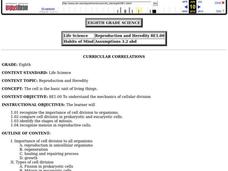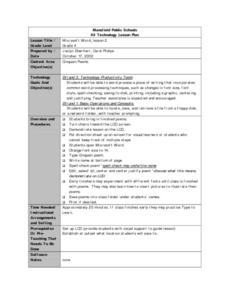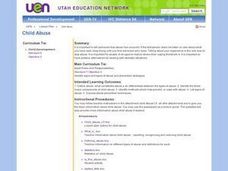Curated OER
Bio-Poem
Students explore parts of speech that relate to their personality characteristics. They examine parts of speech online, and compose a bio-poem that combines the parts of speech with a biography.
Curated OER
Cinco De Mayo
Students investigate the historical background of the holiday of Cinco de Mayo. They complete a word search, explore various websites, and create a pinata that is papered with facts about the holiday.
Curated OER
Recycle! Recycle! Recycle!
Students investigate recycling and reusing. They view an online video, create an recycled art collage using picture files in Inspiration software, and write a choral poem about recycling.
Curated OER
Meteorology
Fourth graders study how atmospheric conditions change while naming the things that make the weather change. They investigate the affects of air masses, weather fronts and high/low pressure by looking at weather maps from newspapers.
Curated OER
Populations and Ecosystems
Seventh graders create a model of an ecosystem and label it to show structure and function. They research the food web of an aquatic animal and also trace energy flow from the primary producer up the food chain.
Curated OER
Quilting with Literature: Internet Research and Multi-Media Presentation Skills in AP English
Have your class acquire research skills such as using hotlists and evaluating websites while they study major literary eras. They create multimedia presentation using information from the Internet research.
Curated OER
Direct and Inverse Variation
Eighth graders participate in two data collection activities that involve direct and inverse variation. In the pre-assessment, 8th graders categorize numerical, graphical, and verbal representations as linear or nonlinear and determine...
Curated OER
Persuasive Speech
Tenth graders participate in a lesson that is focused on the concept of writing persuasive speechs. They conduct research from a variety of sources in order to gather information to write well informed speeches.
Curated OER
Respiration in Sammy's Cells
Students practice translating biological ideas into graphical representations and explore respiration in the context of an exercise session in this 50 minute lesson on aerobic and anaerobic respiration. The lesson includes a question...
Curated OER
Warm & Cool Coloring
Students identify, explain and use the basic elements of design. They explore the concept of warm and cool colors in as simple and fun manner. They label one coloring book picture warm and the other picture cool. They color the...
Curated OER
Human Body Systems
Seventh graders investigate the structure and function of body systems and their inter-relationships. They draw and label the major body systems, observe demonstrations of various body systems, define key vocabulary terms, and compare...
Curated OER
Reproduction and Heredity
Eighth graders study the importance of cell division, compare cell division in prokaryotic and eucaryotic cells, identify the stages of mitosis and recognize meiosis in reproductive cells.
Curated OER
General Introduction To Microsoft Word
Fourth graders investigate the fundamentals of using Microsoft Word. They practice using the common word processing techniques. Students practice composing a document and experiment with changing font sizes, editing tools, saving, and...
Curated OER
Cinquain Poems
Fourth graders investigate the concept of composing a Cinquain poems. They copy a poem from a slide presentation given by the teacher. Students experiment changing the font in the poem. They also receive information about the format used...
Curated OER
People of the Plains:Music and Dance
Fourth graders are given a worksheet stating the goal of the day, different sections to visit, and time spent on each section. They are given the CDs, 4th graders are told to insert the CDs into the computer. Students go to The Plains...
Curated OER
Math Games
Fourth graders participate in a lesson plan that is involved in the breaking of codes using computer games. They access the internet to play math games. The teacher uses powerpoint to help guide students with common problems in loading...
Curated OER
Identifying Acids and Bases
Sixth graders observe the physical and chemical change that can occur in an acid and a base. In this acids and bases lesson plan, 6th graders use cabbage juice to identify, compare, and contrast acids and bases.
Curated OER
What is Climate?
Students explore the differences between climate and weather. For this introductory lesson of a climate unit, students discuss the vocabulary and concepts associated with weather and climate. They build their information base for the...
Curated OER
Microsoft Word - Similies
Fourth graders complete an attached simile worksheet. The teacher models the lesson on a LCD screen. They then open a simile template in the correct folder on Microsoft word. They insert similes, spell check their work, and then save...
Curated OER
Social Studies: Child Abuse
Students discuss the difference between child abuse and discipline. During a discussion, they identify the types of abuse and prevention methods. In groups, students examine various scenarios and determine whether or not the situations...
Curated OER
Storage Hunt
Students create visual examples of each type of storage that should be found incorporated throughout the home. They also visually identify the difference between built-in storage and furniture storage. Students then create two collages...
Curated OER
Introduction to Korean Language and Writing
Learners explore the written Korean language and its history. They demonstrate the formation of the Korean characters and pronounce them. As they research the historical information of Hangul, they compare it to the high literacy rate in...
Curated OER
Chemical and Physical Changes
Students experiment, identify and apply the concepts of chemical and physical changes utilizing real-world examples. They discuss and model physical and chemical changes, answer guided questions and play a game that reinforces the...
Curated OER
Building Staircases: Understanding Slope
Students recognize the importance of slope. They use blocks to model the slope of a line and calculate the slope of a line on a coordinate grid. Afterward, they describe objects they encounter in their everyday lives that have slopes.




